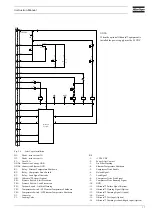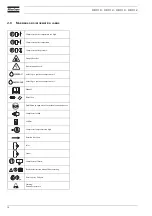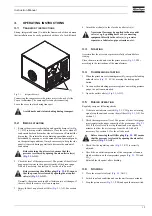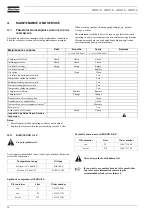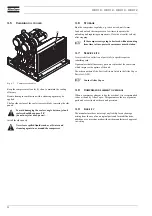
7
Instruction Manual
1.5
S
AFETY
DURING
MAINTENANCE
AND
REPAIR
Maintenance, overhaul and repair work shall only be carried out by
adequately trained personnel; if required, under supervision of someone
qualified for the job.
1
Use only the correct tools for maintenance and repair work, and only
tools which are in good condition.
2
Parts shall only be replaced by genuine Atlas Copco replacement parts.
3
All maintenance work, other than routine attention, shall only be
undertaken when the unit is stopped. Steps shall be taken to prevent
inadvertent starting. In addition, a warning sign bearing a legend such as
”work in progress; do not start” shall be attached to the starting
equipment. On engine-driven units the battery shall be disconnected and
removed or the terminals covered by insulating caps. On electrically
driven units the main switch shall be locked in open position and the
fuses shall be taken out. A warning sign bearing a legend such as ”work
in progress; do not supply voltage” shall be attached to the fuse box or
main switch.
4
Before dismantling any pressurized component, the compressor or
equipment shall be effectively isolated from all sources of pressure and
the entire system shall be relieved of pressure. Do not rely on non-return
valves (check valves) to isolate pressure systems. In addition, a warning
sign bearing a legend such as ”work in progress; do not open” shall be
attached to each of the outlet valves.
5
Prior to stripping an engine or other machine or undertaking major
overhaul on it, prevent all movable parts from rolling over or moving.
6
Make sure that no tools, loose parts or rags are left in or on the machine.
Never leave rags or loose clothing near the compressor air intake.
7
Never use flammable solvents for cleaning (fire-risk).
8
Take safety precautions against toxic vapours of cleaning liquids.
9
Never use machine parts as a climbing aid.
10 Observe scrupulous cleanliness during maintenance and repair. Keep
away dirt, cover the parts and exposed openings with a clean cloth, paper
or tape.
11 Never weld on or perform any operation involving heat near the oil
system. Oil tanks must be completely purged, e.g. by steam-cleaning,
before carrying out such operations. Never weld on, or in any way
modify, pressure vessels. Disconnect the alternator cables during arc
welding on the unit.
12 Use only lubricating oils and greases recommended or approved by Atlas
Copco or the machine manufacturer. Ascertain that the selected
lubricants comply with all applicable safety regulations, especially with
regard to explosion or fire-risk and the possibility of decomposition or
generation of hazardous gases. Never mix synthetic with mineral oil.
13 Protect the air intake filter, electrical and regulating components, etc., to
prevent moisture ingress, e.g. when steam-cleaning.
14 When performing any operation involving heat, flames or sparks on a
machine, the surrounding components shall first be screened with non-
flammable material.
15 Never use a light source with open flame for inspecting the interior of a
machine.
16 Disconnect –battery-clamp before starting electrical servicing or welding
(evt. turn battery-switch in “off” position).
17 When repair has been completed, the machine shall be barred over at
least one revolution for reciprocating machines, several revolutions for
rotary ones to ensure that there is no mechanical interference within the
machine or driver. Check the direction of rotation of electric motors
when starting up the machine initially and after any alteration to the
electrical connection(s) or switch gear, to check that the oil pump and the
fan function properly.
18 Maintenance and repair work should be recorded in an operator’s
logbook for all machinery. Frequency and nature of repairs can reveal
unsafe conditions.
19 When hot parts have to be handled, e.g. shrink fitting, special heat-
resistant gloves shall be used and, if required, other body protection shall
be applied.
20 When using cartridge type breathing filter equipment, ascertain that the
correct type of cartridge is used and that its useful service life is not
surpassed.
21 Make sure that oil, solvents and other substances likely to pollute the
environment are properly disposed of.
22 Before clearing the unit for use after maintenance or overhaul, check that
operating pressures, temperatures and speeds are correct and that the
control and shutdown devices function correctly.
1.6
T
OOL
APPLICATIONS
SAFETY
Apply the proper tool for each job. With the knowledge of correct tool use
and knowing the limitations of tools, along with some common sense, many
accidents can be prevented.
Special service tools are available for specific jobs and should be used when
recommended. The use of these tools will save time and prevent damage to
parts.
1.7
S
PECIFIC
SAFETY
PRECAUTIONS
Batteries
When servicing batteries, always wear protecting clothing and glasses.
1
The electrolyte in batteries is a sulphuric acid solution which is fatal if it
hits your eyes, and which can cause burns if it contacts your skin.
Therefore, be careful when handling batteries, e.g. when checking the
charge condition.
2
Install a sign prohibiting fire, open flame and smoking at the post where
batteries are being charged.
3
When batteries are being charged, an explosive gas mixture forms in the
cells and might escape through the vent holes in the plugs. Thus an
explosive atmosphere may form around the battery if ventilation is poor,
and can remain in and around the battery for several hours after it has
been charged. Therefore:
- never smoke near batteries being, or having recently been, charged,
- never break live circuits at battery terminals, because a spark usually
occurs.
4
When connecting an auxiliary battery (AB) in parallel to the unit battery
(CB) with booster cables: connect the + pole of AB to the + pole of CB,
then connect the - pole of CB to the mass of the unit. Disconnect in the
reverse order.
Summary of Contents for ORV 10
Page 1: ...ORV 10 ORV 12 ORX 10 ORX 12 Instruction Manual for Portable Compressors English ...
Page 2: ......
Page 43: ......



















